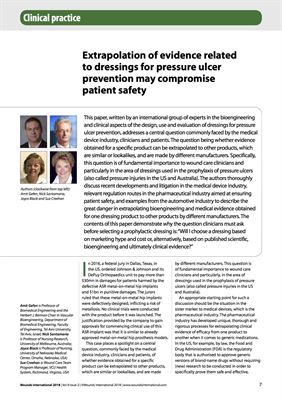New study shows lack of clinical evidence may compromise patient safety

Extrapolation of bioengineering and clinical evidence obtained from one prophylactic dressing to other dressings manufactured by different manufacturers could compromise patient safety, according to a new paper published in Wounds International Journal. The publication also shows that the Mölnlycke Mepilex®Border dressings are the only dressings that currently have robust cost-effectiveness data at both the individual hospital and national levels.
Given the magnitude of the problem with pressure ulcers, for example costing the U.S. health care system USD 11 billion annually[1], the publication, conducted by by Amit Gefen, Nick Santamaria, Sue Creehan and Joyce Black, argues there are compelling arguments for stricter regulation of parts of the medical devices industry development of clinical evidence and its use in marketing practices.
The 70+ clinical studies on Mepilex Border makes it the world’s largest evidence base on pressure ulcer dressings.[2] However, the current lack of regulation of marketing practices means the market is swamped with products which possess different design and attributes, to Mepilex® Border but use these studies to support their own effectiveness.
Professor Amit Gefen comments:
“Compared with the rigorous and thorough processes in place within the pharmaceutical industry for extrapolation of clinical evidence of efficacy from one product to another, parts of the medical devices industry is operating in a grey zone.These differences in regulation very likely originate from the simple fact that there is only one possible way of producing a drug – based on its chemical formula, but probably infinite ways for engineering design of a device. As a result, in the medical device industry, it is far more difficult to determine whether similar products, products that make the same claims of a clinical effect, or lookalike products, are actually equivalent in effectiveness. This places undue responsibility on clinicians when interpreting marketing materials.”
Professor Nick Santamaria comments:
“Whereas a drug, or at a minimum the active component in a drug, is made of a specific, unique chemical composition, with a formula that is exclusive and chemically defined for achieving a certain clinical effect, medical devices may use diverse design principles and variations and still claim the same effect.”
The consequence is that in the wound prevention and management industryin particular, this opens the path for cheap production of lookalikes for nearly every successful technology or product.The study argues that the price argument typically overweighs the existence of published high-quality evidence of clinical efficacy. As a result, patients are unfortunately often prescribed compromised or sometimes even inadequate products. The authors therefore recommend that in light of current regulations and limitations within the wound care industry clinicians be guided by high quality clinical evidence relating to the specific dressing in question when choosing a prophylactic dressing for pressure ulcer prevention.
About the authors
Amit Gefenis Professor of Biomedical Engineering and the Herbert J. Berman Chair in Vascular Bioengineering, Department of Biomedical Engineering, Faculty of Engineering, Tel Aviv University, Tel Aviv, Israel;
Nick Santamaria is Professor of Nursing Research, University of Melbourne, Australia;
Sue Creehanis Wound Care Team Program Manager, VCU Health System, Richmond, Virginia, USA;
Joyce Black is Professor of Nursing, University of Nebraska Medical Center, Omaha, Nebraska, USA.
The full paper can be found here.
[1]Padula WV. The Real-World Effectiveness and Value of Sacral Dressings to Prevent Hospital-Acquired Pressure Inquires in Academic Medical Centers: An Observational Cohort Study. Poster presented at SAWC, Spring 2017. Agency for Healthcare Research and Quality. Preventing pressure ulcers in hospitals. [see Press Release on litigation]
[2]Gefen et al, “Extrapolation of evidence-related to dressings for pressure ulcer prevention may compromise patient safety”, Wounds International 2018, Vol 9 Issue 2
For more information, please contact:
Jenny Johansson, Global Communications Manager
jenny.johansson@molnlycke.com
Phone: +46 (0) 739 41 29 23
About Mölnlycke
Mölnlycke is a world-leading medical solutions company. We design and supply solutions to enhance performance at every point of care – from the hospital to the home. We specialise in solutions for managing wounds, improving surgical safety and efficiency, and preventing pressure ulcers. Our products are available in approximately 100 countries worldwide.
Mölnlycke was founded in 1849. Our headquarters are in Gothenburg, Sweden and we employ around 7,500 people. Since 2007, we belong to Investor AB, the leading owner of Nordic-based international companies.
Tags:


